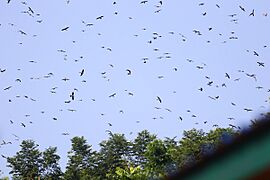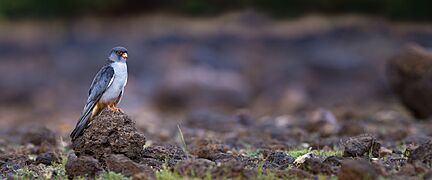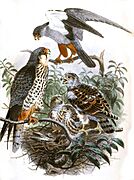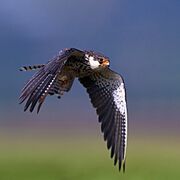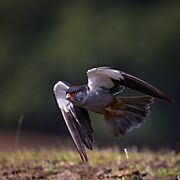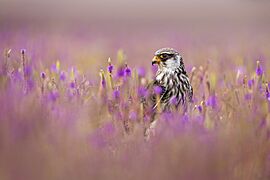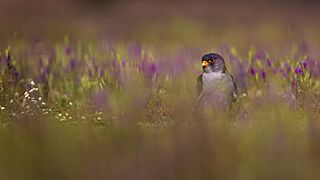Amur falcon facts for kids
Quick facts for kids Amur falcon |
|
|---|---|
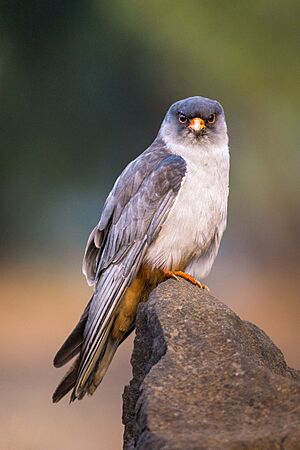 |
|
| Male | |
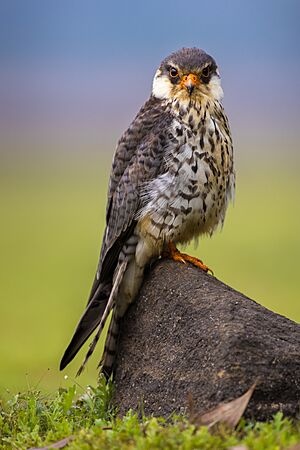 |
|
| Female | |
| Conservation status | |
| Scientific classification | |
| Genus: |
Falco
|
| Species: |
amurensis
|
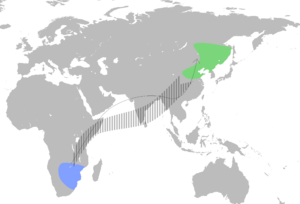 |
|
Breeding Non-breeding |
|
| Synonyms | |
|
|
The Amur falcon (Falco amurensis) is a small, speedy bird of prey from the falcon family. These amazing birds breed in places like south-eastern Siberia and Northern China. When winter comes, they fly incredibly long distances in huge groups, crossing India and even the Arabian Sea! Their journey ends in Southern and East Africa where they spend the colder months.
Contents
What Does the Amur Falcon Look Like?
Male Amur Falcons
Male Amur falcons are mostly dark grey, almost black, on their upper bodies. Their thighs and the area under their tail are a reddish-brown color. When they fly, you can see their white wing lining, which stands out against their dark wing feathers. Their wings are long, like most falcons, stretching about 63–71 centimeters wide. When they are resting, their wing tips reach or go a little past their tail.
Female Amur Falcons
Female Amur falcons can be a bit harder to spot. They have patterns similar to many other falcons. But you can tell them apart by their bright orange eye-ring, a red cere (the waxy part above their beak), and reddish-orange feet. Young falcons look a lot like young red-footed falcons, but they don't have the light brown feathers under their wings.
Amur Falcon Family Tree
For a long time, people thought the Amur falcon was just a type of red-footed falcon. But now, scientists agree it's its own unique species. Even so, it's still the closest relative to the red-footed falcon. The name Falco comes from a Latin word meaning "sickle," which describes the bird's sharp claws. The species name amurensis comes from Amurland in south-eastern Siberia, where these birds live.
Where Do Amur Falcons Live and Travel?
Amur falcons spend their breeding season in East Asia. This includes places like Transbaikalia, Amurland, and northern Mongolia. When winter approaches, they begin an amazing journey. They fly across a wide area, including India and Sri Lanka. Sometimes they go even further east to Thailand and Cambodia. Then, they fly over the Arabian Sea to reach southern Africa.
Scientists believe that strong winds blowing west help the birds flying over India. These winds are very strong at about 3000 meters high. The falcons are thought to fly above 1000 meters during their migration. Their return journey to their breeding grounds is a little further north. Because they fly such long distances over the ocean, Amur falcons have been seen in unexpected places. These include Italy, Sweden, and even the United Kingdom!
Amur Falcon Habits
What Do Amur Falcons Eat?
Amur falcons mostly hunt in the late evening or early morning. They catch many different kinds of insects in the air or on the ground. They often grab their prey while flying, sometimes hovering in place first. They will also land to pick up food. In winter, their diet is almost entirely insects. But when they are raising their young, they also eat small birds, mammals, and amphibians.
In Africa, the rainy season brings huge swarms of termites, locusts, ants, and beetles. These provide plenty of food for the falcons. Their long flight over the Arabian Sea happens at the same time as dragonfly migration. These dragonflies are thought to be an important food source during the hardest part of their journey.
Nesting and Raising Young
During their migration, Amur falcons stay in open forests or grasslands. They often roost (rest) together in large groups on exposed branches or wires. For breeding, they prefer open wooded areas with marshes. Their breeding season is from May to June. Several pairs might nest close to each other. They often reuse old nests built by other birds of prey or crows. They might even use hollows in trees.
A female falcon lays three or four eggs, usually two days apart. Both parents take turns sitting on the eggs and feeding the chicks. The eggs hatch after about a month. The young birds are ready to leave the nest about a month after hatching.
Tiny Hitchhikers
Amur falcons can host tiny creatures called lice. Three types of lice that live on Amur falcons are Degeeriella rufa, Colpocephalum subzerafae, and Laembothrion tinnunculi.
Protecting Amur Falcons
The Amur falcon has a very wide breeding area and a large population. Because of this, experts say they are of "least concern" for extinction. However, their habit of flying in huge groups makes them easy targets for hunting. This happens in parts of northeastern India and eastern Africa.
In 2012, there were reports of many Amur falcons being trapped and caught in Nagaland, India. A successful campaign was started to stop this killing. As part of this effort, three falcons were fitted with small satellite trackers. These trackers allowed scientists to follow their amazing migration journey.
Gallery
-
Amur falcon female in a grassland habitat, in Maharashtra, India
-
Amur falcon male in a rocky habitat in Maharashtra, India
-
Individual male at Lower Sabie, Kruger National Park, South Africa
See also
- The Pangti Story



